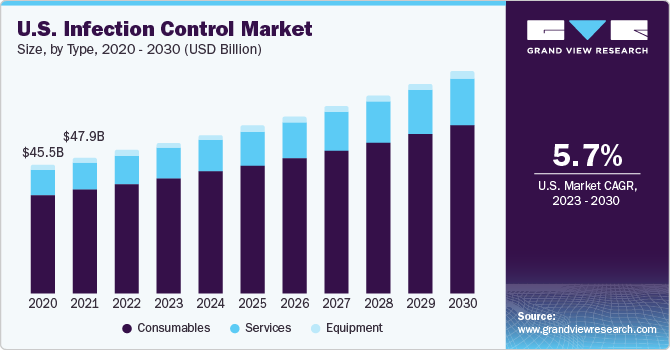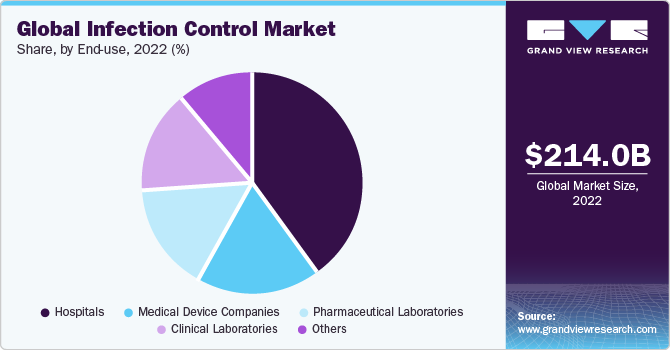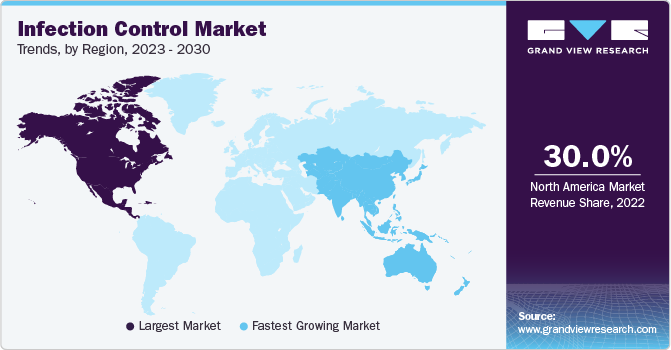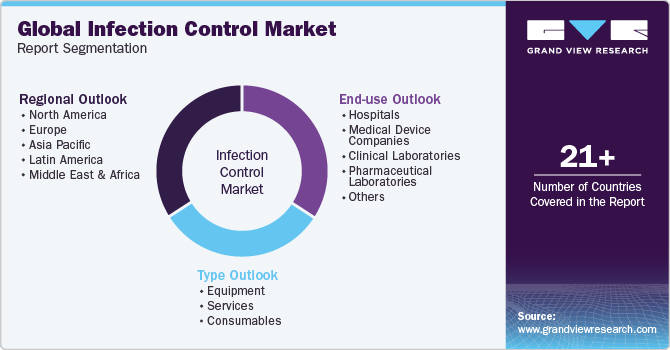- Home
- »
- Medical Devices
- »
-
Infection Control Market Size & Share, Industry Report, 2030GVR Report cover
![Infection Control Market Size, Share & Trends Report]()
Infection Control Market Size, Share & Trends Analysis Report By Type (Equipment, Services, Consumables), By End-use (Hospitals, Medical Device Companies, Clinical Laboratories, Pharmaceutical Companies, Others), By Region, And Segment Forecasts, 2023 - 2030
- Report ID: GVR-1-68038-822-0
- Number of Report Pages: 120
- Format: PDF, Horizon Databook
- Historical Range: 2018 - 2021
- Forecast Period: 2023 - 2030
- Industry: Healthcare
Infection Control Market Size & Trends
The global infection control market size was valued at USD 214.0 billion in 2022 and is expected to grow at a compound annual growth rate (CAGR) of 6.7% over the forecast period from 2023 to 2030. The market is primarily driven by an increasing number of surgical & clinical procedures that intensively require infection prevention. The high preference is presumed to be a consequence of positive clinical outcomes associated with using infection control. The COVID-19 pandemic has positively impacted market growth as the demand for sterilization and disinfection in hospitals and clinics, pharmaceutical, and medical device companies has increased.

According to CNBC, the manufacturing of sanitizer products witnessed rise of 60% during the pandemic in the U.S. alone. This shows the growth potential for infection control products in the coming years. An increase in outsourcing sterilization services and the introduction of advanced sterilizing solutions are further contributing to the growth of the market for infection control. One of the important growth drivers is the increasing number of government initiatives to ensure highly intensive infection prevention. Government organizations are increasingly involved in issuing guidelines to promote awareness and efficient prevention measures globally, which is expected to contribute to market growth throughout the forecast period. For instance, the World Health Organization (WHO) has issued guidelines for preventing and controlling pandemic- and epidemic-prone acute respiratory diseases in healthcare. The guidelines range from standard precautions such as hand hygiene and usage of personal protective equipment to guidelines for disinfection and sterilization.
According to the statistics published by WHO, Acute Respiratory Diseases (ARDs) are one of the major causes of high mortality rates globally. Approximately 4.0 million deaths occur every year due to ARDs. The statistics mentioned above exemplify the high need for stringent prevention and control. Diseases such as pneumonia and infections such as the bloodstream, urinary tract, surgical site, and MRSA constitute most hospital-acquired infections. Other major Hospital-acquired Infections (HAI) include catheter-associated urinary tract infections, ventilator-associated pneumonia, and catheter-related bloodstream. One of the utmost concerns for the market is HAIs, which affect patient recovery; thereby, mortality rates are majorly getting impacted globally.
According to a practical guide published by the WHO on preventing hospital-acquired infections, the increase in hospitalization duration with surgical infections was approximately eight days. These prolonged stays are predicted to significantly contribute to the overall costs incurred during the hospitalization period, thus, raising the clinical urgency for adopting infection prevention measures. It is presumed that prolonged hospital stay is also not economical for the hospitals and healthcare payers due to excessive usage of resources to treat the acquired infection. These additional costs are majorly generated through increased usage of drugs, additional diagnostic studies, and laboratory equipment, creating a resource allocation imbalance.
Type Insights
Based on the type, the global infection control market is segmented into equipment, services, and consumables. The consumables segment dominated the market for infection control and accounted for the largest revenue share in 2022. The dominant share captured by consumables is predicted to be a consequence of consistent usage and the short life cycle of these products. Consumables are being extensively incorporated in disinfection, sterilization, and other control procedures and are indispensable parts of the procedures mentioned above, accounting for a larger share. Under consumables, personal protective equipment held a substantial share as of 2022.
Further, the equipment segment is classified as disinfectors and sterilization equipment. Again disinfectors are further segmented into washers, flushes, and endoscope reprocessors. The sterilization equipment is segmented into heat sterilization equipment, low-temperature sterilization equipment, radiation sterilization equipment, filtration sterilization equipment, and liquid sterilization equipment. Also, consumables are segmented into infectious waste disposal, disinfectants, sterilization consumables, personal protective equipment, and others.
Various healthcare organizations are advocating and promoting awareness about the benefits of personal protective equipment, which is anticipated to be responsible for a significant share. For instance, W&H company is working on a hygiene portfolio and added the LEXA PLUS CLASS B sterilizer, a new technologically advanced device for easier reprocessing and infection prevention for dental practice workflow.
Based on type, the services segment is expected to grow at the fastest CAGR during the forecast period. This fastest growth is attributed to the high inclination of market players to reduce overall healthcare expenditure and the utilization of benefits involved. It primarily includes cost advantages, increased efficiency of services, enhanced productivity, and a significantly higher focus on the core areas of development, which are critical to a company’s overall profit and growth. The organizations also strive to promote the adoption through issuing guidelines and recommendations for selection, risk assessment, rational usage, removal, and considerations to reduce the risk of transmission of respiratory pathogens to healthcare workers and other medical staff within a healthcare facility. Further, services are segmented into contract sterilization and infectious waste disposal. The contract sterilization segment is again classified into ethylene oxide sterilization, e-beam sterilization, gamma sterilization, and others.
End-use Insights
Based on end use, the global infection control market is segmented into medical device companies, hospitals, pharmaceutical companies, clinical laboratories, and others. The hospital segment dominated the market for infection control and accounted for the largest revenue share of around 40% in 2022 and is also expected to grow at the fastest CAGR of 7.4% over the forecast period from 2023 to 2030. The considerable share is majorly a result of the high probability of getting infected on hospital premises by transmitting blood-borne or respiratory pathogens. Hospital-acquired infections require rigorous control as it is one of the major challenges faced by the market. This has urged public health organizations and hospitals to adopt highly effective control systems. Also, as per research published in NCBI, 40% to 60% of hospital infections were estimated to be at surgical sites.

One of the major concerns is the high probability of infection from pathogens such as drug-resistant, blood-borne, and others in the operating room, because of which the need of the market is growing. For instance, frequent usage of urinary catheters poses a high probability of UTIs and may result in catheter-associated (CA)-UTIs. According to data published by the National Center for Biotechnology Information (NCBI), UTIs account for 25% of all bacterial infections. As per the data published in the National Nosocomial Infection Surveillance (NNIS) system report, the most frequently occurring HAI are associated with CA-bacteriuria and catheterization globally, accounting for 40% of HAIs in the U.S. annually. These factors are expected to widen the future growth prospects of the market.
Regional Insights
North America dominated the infection control market and accounted for the largest revenue share of over 30% in 2022. The substantial share captured by this region is due to a good number of strategic collaborations by key companies in the market to widen their infection control capabilities and product portfolio. In addition, increasing efforts by the established companies to widen their presence across this region is responsible for the dominant share captured by North America. For instance, In January 2017, Advanced Sterilization Products launched the STERRAD 100NX System with ALLClear in the U.S. and is planning to expand its footprint into regions such as Europe, Africa, and the Middle East. In 2020, Advance Sterilization Products got 510(k) clearance from the U.S. Food and Drug Administration (FDA) for a 15-minute time result for the STERRAD VELOCITY® Biological Indicator, which is a device used in the STERRAD System. It offers the fastest way to provide instrument sterilization for healthcare professionals.

Asia Pacific is expected to expand at the fastest CAGR of 8.3% over the forecast period from 2023 to 2030, owing to the growing number of outsourcing organizations, growing expenditure on healthcare, and evolving healthcare standards and infrastructure unprecedently across this region. Government organizations are focusing more on improving infection control standards as it is also one of the important factors contributing to the growth of the Asia Pacific region. The increasing trend of outsourcing by established market players in developed economies to companies in the Asia Pacific region also serves as a key growth impelling factor for the market. For instance, the Asia Pacific Society of Infection Control (APSIC) is a voluntary organization working to establish collaborative partnerships to facilitate quality improvement and conduct infection control research to promote cost-efficient practices throughout the Asia Pacific region.
Key Companies & Market Share Insights
The competition is marked by the extensive implementation of collaborative strategies by major companies such as Advanced Sterilization Products, STERUS Corporation, and Cantel Medical Corporation, which accounts for their dominant market share. These players are highly focused on adopting competitive strategies such as mergers and acquisitions, new product development initiatives, and geographical expansion. For instance, in September 2020, Midmark Corp., a leading company providing dental solutions, announced the launch of the Sterilizer Data Logger and M3 Steam Sterilizer, which will bring speed, compliance, and simplicity to the processing of instruments.
Moreover, in November 2020, Applicon Biotechnology, a part of Getinge, announced the launch of AppliFlex ST, a customizable single-use bioreactor that optimizes processes and reduces labor hours in the lab. Also, companies are entering into collaborative strategies to widen infection control capabilities. For instance, in January 2021, Steris announced the acquisition of Cantel Medical, a global provider of products preventing infection and providing services to dialysis, dental, endoscopy, and life sciences customers. Similarly, 3M launched a four-hour rapid readout biological indicator for vaporized hydrogen peroxide sterilization, designed to give results in 4 hours and monitored steam sterilization loads. The product was launched to expand the company’s product portfolio.
Key Infection Control Companies:
- 3M
- Belimed AG
- O&M Halyard or its affiliates.
- Getinge Group
- ASP
- MATACHANA
- Sterigenics U.S., LLC – A Sotera Health company
- MMM Group
- Cantel Medical Corp.
- STERIS plc.
- Midmark Corporation.
- Medivators Inc
- W&H
Infection Control Market Report Scope
Report Attribute
Details
Market size value in 2023
USD 227.7 billion
Revenue forecast in 2030
USD 359.6 billion
Growth rate
CAGR of 6.7% from 2023 to 2030
Base year for estimation
2022
Historical data
2018 - 2021
Forecast period
2023 - 2030
Report updated
November 2023
Quantitative units
Revenue in USD million/billion and CAGR from 2023 to 2030
Report coverage
Revenue forecast, company ranking, competitive landscape, growth factors, and trends
Segments covered
Type, end-use, region
Regional scope
North America; Europe; Asia Pacific; Latin America; MEA
Country scope
U.S.; Canada; UK; Germany; France; Italy; Spain; Denmark; Sweden; Norway; China; Japan; India; Australia; South Korea; Thailand; Brazil; Mexico; Argentina; Saudi Arabia; South Africa; UAE; Kuwait
Key companies profiled
3M; Belimed AG; O&M Halyard or its affiliates.; Getinge Group; ASP; MATACHANA; Sterigenics U.S., LLC – A Sotera Health company; MMM Group; Cantel Medical Corp.; STERIS Corporation; Midmark Corporation.; Medivators Inc.; W&H
Customization scope
Free report customization (equivalent up to 8 analyst’s working days) with purchase. Addition or alteration to country, regional & segment scope
Pricing and purchase options
Avail customized purchase options to meet your exact research needs. Explore purchase options
Global Product Lifecycle Management Market Report Segmentation
This report forecasts revenue growth at global, regional, and country levels and provides an analysis of the latest industry trends in each of the sub-segments from 2018 to 2030. For this study, Grand View Research has segmented the global infection control market report based on type, end use, and region:

-
Type Outlook (Revenue, USD Billion, 2018 - 2030)
-
Equipment
-
Disinfectors
-
Washers
-
Flushes
-
Endoscope Reprocessors
-
-
Sterilization Equipment
-
Heat Sterilization Equipment
-
Low Temperature Sterilization Equipment
-
Radiation Sterilization Equipment
-
Filtration Sterilization Equipment
-
Liquid Sterilization Equipment
-
-
Others
-
-
Services
-
Contract Sterilization
-
Ethylene Oxide Sterilization
-
E-beam Sterilization
-
Gamma Sterilization
-
Others
-
-
Infectious Waste Disposal
-
-
Consumables
-
Infectious Waste Disposal
-
Disinfectants
-
Sterilization Consumables
-
Personal Protective Equipment
-
Others
-
-
-
End-use Outlook (Revenue, USD Billion, 2018 - 2030)
-
Hospitals
-
Medical Device Companies
-
Clinical Laboratories
-
Pharmaceutical Laboratories
-
Others
-
-
Regional Outlook (Revenue in USD Million, 2018 - 2030)
-
North America
-
U.S.
-
Canada
-
-
Europe
-
UK
-
Germany
-
France
-
Italy
-
Spain
-
Denmark
-
Sweden
-
Norway
-
-
Asia Pacific
-
Japan
-
China
-
India
-
Australia
-
Thailand
-
South Korea
-
-
Latin America
-
Brazil
-
Mexico
-
Argentina
-
-
Middle East & Africa
-
South Africa
-
Saudi Arabia
-
UAE
-
Kuwait
-
-
Frequently Asked Questions About This Report
b. The global infection control market size was estimated at USD 214.0 billion in 2022 and is expected to reach USD 227.7 billion in 2023.
b. The global infection control market is expected to grow at a compound annual growth rate of 6.7% from 2023 to 2030 to reach USD 359.6 billion by 2030.
b. North America dominated the infection control market with a share of 33.63% in 2022. This is attributable to growing number of surgical procedures that require high intensity infection prevention.
b. Some key players operating in the infection control market include 3M Company, Belimed AG, Halyard Health, Inc., Getinge Group, Advanced Sterilization Products, Matchana Group, Sterigenics International, MMM Group, Cantel Medical Corporation, and STERUS Corporation.
b. Key factors that are driving the infection control market growth include the rising number of government initiatives to ensure a high degree of infection prevention.
Share this report with your colleague or friend.
![gvr icn]()
NEED A CUSTOM REPORT?
We can customize every report - free of charge - including purchasing stand-alone sections or country-level reports, as well as offer affordable discounts for start-ups & universities. Contact us now
![Certified Icon]()
We are GDPR and CCPA compliant! Your transaction & personal information is safe and secure. For more details, please read our privacy policy.
We are committed towards customer satisfaction, and quality service.
"The quality of research they have done for us has been excellent."





